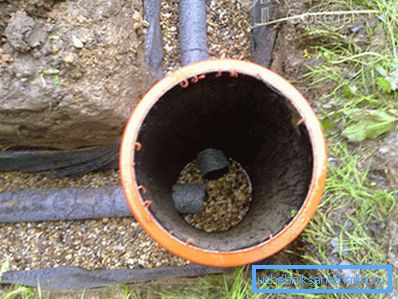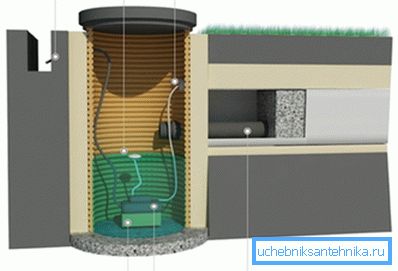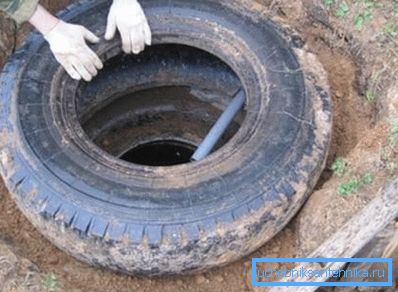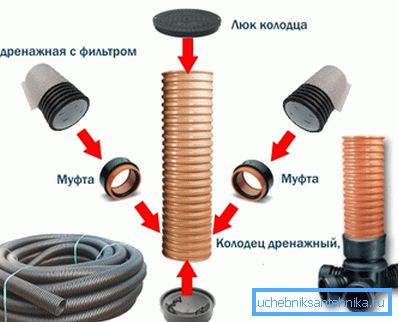Drainage well - types, materials and installation of
To drain the excess water from the suburban area, it must be equipped with a special system consisting of drains (perforated pipes) that are output to special wells. There may be several of them on the territory of the site. It is possible to mount a drainage well from concrete rings, plastic, tires.
Such devices are designed for different tasks, based on this, differ in size and design.

Mine Types
The following types of drainage devices are distinguished:
- turning;
- lookout;
- collector;
- absorption;
Swivel counterparts

Such devices are needed to clean clogs and remove debris that accumulates inside drains.
- This kind of wells is constructed on every second bend of drains, besides this - where several pipes converge (then such a structure is additionally called central).
- The device makes available and the outlet and supply parts of the network.
- The size and depth of this type of drainage well depend on whether people are planning to go inside it for maintenance or repair.
- Then the diameter of the structure, which is essentially an inspection, should be at least 1 m.
Viewing analogues

Such wells are needed to control the work of drainage sewers. The mine of such structures must be of sufficient size so that an employee can descend into it. It inspects on-site network status and, if necessary, fixes problems.
Note! Often, the viewing device performs several tasks at once. For example, it can be both rotary and nodal.
Filtering facilities
Now that such filtering (absorption) drainage wells. Put them where you need to drain the territory, but it is impossible to carry out drainage to the mains. The depth of the structure in this case is about 2 m.
Installation of absorption structures is carried out as follows.
- First, dig a pit.
- 30 cm of rubble is poured on its bottom.
- Next is the well shaft. The best option is to use a plastic pipe for this, having a minimum diameter of 1.5 m.
- Next, the mine to the top is filled with gravel, rubble, slag or broken brick.
- Then the space between the walls of the pipe and the pit is covered with gravel.
- After that, the drainage well is covered with geotextiles and covered with a layer of earth.
- Such a structure will divert water into the soil in a natural way.
Receivers

Water intake or collector facilities are the final tanks of closed drainage. The instruction prescribes to put them for the collection and accumulation of water. It is then pumped off the site - into the nearest ditch, reservoir or ravine.
It is best for the collector to purchase a ready-made plastic tank having a waterproof bottom.
What materials are the drainage elements constructed from?
- Concrete drainage wells are constructed from prefabricated rings that have different diameters and heights. Installation of elements of such structures is carried out in good time dug a pit, using a crane-manipulator. The main advantage of reinforced concrete wells - durability and strength, the disadvantage is the complexity of the installation.
- Devices made of plastic are becoming increasingly popular. Their installation is quick and easy, the price of construction is not very big, the mass is small, they are equipped with all the necessary branches. Plastic is not afraid of corrosion, its service life exceeds 50 years.
Tubes are connected to the reservoir using rubber lip seals, they retain airtightness for decades. The well itself is a corrugated pipe with stiffeners.
Note! If your site is on heaving soil (clay, loam, etc.), then get a drainage conical well made of plastic. It may have perforated walls or solid and a height of 1 / 2.5 m. The structure in the form of a cone, that is, with expansion downwards, does not allow the forces of frost heaving to push the structure to the surface.
Arrangement of drainage facilities
Concrete collectors should have a deaf bottom. For this purpose, you can use ready-made elements.
Concrete wells

- First of all, the excavation of the necessary depth is being dug.
- In it the pillow from sand and crushed stone is poured. Next, it is filled with cement mortar.
- Then the bottom / tray of the structure is put. Beforehand it is coated with mastic of bitumen.
- After this, the installation of the drainage well. It can consist of one or several well rings, depending on the size.
- Then drains are mounted.
- To protect the mine from leaks, all its joints are coated with mortar and then with bitumen.
- After that, the free part of the pit is filled with gravel, and on top of it with soil and rammed.
- In the pre-set frame is mounted hatch.
The use of scrap materials

Original drainage well of tires. In this case, you can use the old "rubber", both from passenger cars and trucks. Such a device is most suitable for the construction of the absorption pit.
Stages of work are as follows.
- Digging a pit with a depth of 2 m.
- Backfill at its bottom of the base of rubble.
- Launch your own hands into the pit of the required number of tires.
- Filling the inside of the mine with filtrate - gravel, rubble, broken bricks.
- Filling the remaining gap between the pit and gravel walls.
- Shelter structures geotextile, and then the ground.
Installation of plastic tanks

For a plastic well shaft, you need to buy corrugated pipes of the required diameter.
- For viewing devices, a diameter of 34 or 46 cm is sufficient. So you will be able, bent, to run your hand into the well and clean the drain with water pressure from a hose.
- For filtering and storage wells, products with a cross section of 57.5 and 69.5 cm are recommended.
- If you plan to go inside, you need pipes with a diameter of 92.5 mm.
In addition to plastic walls, you will need rubber seals, a plastic bottom and a sunroof / cover.
Stage of installation of plastic construction.
- First you need to prepare the pipe of the desired length. For this, the necessary piece is cut off. It is equipped with holes for connecting drains, in which seals are placed.
- Next, you need to make a bottom (except for filtering analogues). To do this, sand and gravel base is poured and filled with mortar. When the mixture dries, the base is covered with geotextile, a plastic bottom is placed on it.
- The pipe goes down into the pit and connects to the bottom. Joints are processed by bitumen.
- Further in the mine are drains.
- Now it can be sprinkled with fine gravel.
- Installation of drainage wells made of plastic is completed by mounting the hatch. (See also the article Well hatches: features.)
Conclusion
If you choose the right types of drainage devices you need and correctly install them, then you will not have problems with the discharge of water from the site. Remember that the drainage well on the clay must have a conical shape. Then the frosty swell will not squeeze it to the surface. The video in this article will help you learn a lot more.